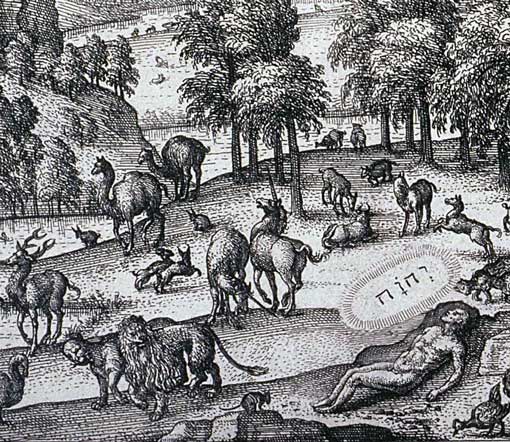
Creation: Adam Among the Animals (detail), Pieter
van der Borcht.
Click
for a large image.
Pieter (or Petrus or Pierre) van der Borcht was born in the city of Malines (Mechelen), southwest of Antwerp in the Netherlands, around 1540 (some say 1545). He died around 1608. He is thought to have been the son of Jacques van der Borcht, also an artist, who in 1562 became the doyen of the painter's guild in Malines. The first published artwork attributed to the younger van der Borcht was printed in 1552 by Jacob van Liesvelt in a book titled Dat Vyants net der booser wercken. The book contains 17 woodcut illustrations, the last of which, a picture of the Virgin Mary holding the symbol of the town of Malines, is signed "Fecit Petrus van der Borcht 1552". Pieter would have been only 12 years old at the time, but with a guild-member artist for a father it is certainly possible he was already working by then, at least as an apprentice.
By 1564 van der Borcht was working for Christopher Plantin, who had his press in Antwerp. Plantin's journal for December, 1564 records that Pierre van der Borcht, a painter from Malines, would be creating drawings for an emblem book (the Emblemata of Sambucus) that Plantin wanted to publish. Van der Borcht did the drawings, but did not cut the wood blocks used for printing. In 1565 van der Borcht received a commission from Plantin to make 60 drawings of plants for a herbarium by Rembert Dodoens, the Frumentorum, leguminum, palustrium et aquatilium herbarum historia. Dodoens was also a citizen of Malines, and it is likely that he recommended van der Borcht for the job. Pieter's work so pleased both author and publisher that he was soon the usual illustrator for Plantin's numerous botanical books.
Van der Borcht was still living in Malines in 1572 when disaster, in the form of a Spanish duke, struck the town. At that time part of the Netherlands, including the area of Malines and Antwerp, was under the control of the Spanish king Philip II. The Duke of Alva was sent to the Netherlands by the king in 1567, after uprisings a year earlier, to maintain order and suppress Calvinist and other Reformation heresies. On October 2, 1572 the Duke of Alva and his troops sacked the town of Malines, perpetrating over three days a massacre so horrible that a witness later reported that his hair stood on end when he related, or even remembered, what he saw. Van der Borcht fled with his family to Antwerp, where his friend Plantin took him into his house. Plantin says in in a letter to Arias Montanus of the arrival of the van der Borcht family that both Pieter and his wife were sick and their children were naked; their departure from their home must have been sudden. Plantin allowed the family to live in his house, without requiring payment, for some time.
Van der Borcht remained in Antwerp for the rest of his life. From his arrival there until his death he worked full time for Plantin, illustrating the many liturgical books the press produced, chiefly for the Spanish market. He entered the guild of St Luke of Antwerp, the guild responsible for artists, in 1580, and was doyen of the guild from 1589 to 1592. He later began to engrave his own work using the new medium of copperplate engraving and etching that came into common use after 1564, supplanting woodcuts in most of Plantin's books. Several of Plantin's official printer's marks were also designed by van der Borcht.
In his 56 years as an artist, van der Borcht produced several thousand drawings. Strangely, given his output and popularity, he was largely forgotten until relatively recently, when his work became more known through the Plantin archives at the Plantin-Moretus Museum in Antwerp.

Creation: Adam Among the Animals (detail), Pieter
van der Borcht.
Click
for a large image.

Some of the many books illustrated by Pieter van der Borcht for Plantin: